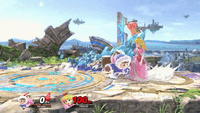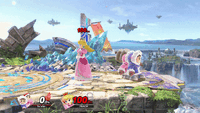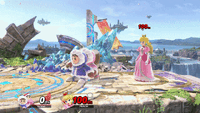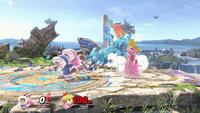User:Yo'ster/Desyncing updates: Difference between revisions
(→Desyncing Methods: Throw buffer) |
(→Variants: Continuing to elaborate...) |
||
| Line 61: | Line 61: | ||
'''Leader followup''' The lead climber converts after throwing their opponent while the desynced partner is positioned to extend the combo. The 2nd climbers's Squall Hammer is often used as part of '''The Nut''', which works on all characters, except Pichu and Jigglypuff, although rage can make it unreliable for another handful of the cast. | '''Leader followup''' The lead climber converts after throwing their opponent while the desynced partner is positioned to extend the combo. The 2nd climbers's Squall Hammer is often used as part of '''The Nut''', which works on all characters, except Pichu and Jigglypuff, although rage can make it unreliable for another handful of the cast. | ||
'''Partner followup''' The 2nd climber converts after the 1st throws their opponent. The desynced leader positions themselves to extend the combo. | '''Partner followup''' The 2nd climber converts after the 1st throws their opponent. The desynced leader positions themselves to extend the combo. The duo can perform alternating aerials for ladder combos at unusually early percents and/or use the partner's forward air as a finisher. | ||
==Desync Combos== | ==Desync Combos== | ||
Revision as of 08:59, July 15, 2024
Overview
The Ice Climbers are unique in that the player is controlling two characters simultaneously. The lead climber (Popo by default) is controlled directly while the partner climber (Nana by default) is CPU-controlled and follows the player's actions on a slight delay, attacking alongside the leader. If both are separated for any reason, the partner AI will switch to prioritize returning to the leader. During this time, they are not synchronized, or "desynched", meaning the partner will not follow any player inputs until getting within a certain distance of the leader. While the partner's separate actions are unpredictable and are often unfavorable, they can be manipulated to perform basic actions like attacking an opponent.
Desynching can also be set up intentionally without having to separate the two. This is partially due to how the partner has a several frame delay during most inputs, and from having slightly different attributes from the leader: jump height, gravity, fall speed, and dash (as of Ultimate). Specific maneuvers take advantage of these by using specific means to delay the partner's actions, the most common being during grabs to allow the partner to attack a captive opponent or regrab them (though this particular method no longer applies in Ultimate due to changes made to grabs). Once both climbers are desynched, they are essentially performing different actions as long as the player continues to press buttons. Desynching can allow the player to perform a move with either climber, whilst inputting a different command to the other, which can allow for highly damaging true combos, zero-to-death strings, and even infinites. It can also be used as a means of multitasking if the player is presented with multiple desirable opportunities.
Desync subtypes
There are several kinds of desync that differ in execution. Most methods differ by game.
Neutral-based desyncs, or NBDs, are used in a "neutral state", i.e. not requiring an opponent to be hit or grabbed. Aerial NBDs involve the partner acting first, while Grounded NBDs involve the leader acting first.
Combo-based desyncs, or CBDs, require an opponent to be hit or grabbed. Most CBDs are kill confirms.
Miscellaneous desyncs, or MDs, don't apply to the categories above. They are situational, but have potential.
"Unconventional" desyncs, or UDs, have poor utility, can most likely leave any one of the Ice Climbers vulnerable, and possess little to no real practical use.
Desyncing Methods
Aerial animation
An aerial animation desync involves executing an animation (from aerials, empty hops, autocancels, or airdodges) just before landing. This can be performed in any of the three Smash games the duo is in, but it's easiest to perform in SSBU due to the partner's higher jump height, gravity, and fall speed. When performing an aerial animation desync in SSBU, only the leader will undergo the aerial's landing lag.
Primary Variants
Aerial autocancel: Performed by buffering 2 aerials back-to-back from a short-hop. The following aerial strings can be used:
Up Aerial - Up Aerial Up Aerial - Back Aerial Up Aerial - Neutral Aerial Back Aerial - Up Aerial Back Aerial - Back Aerial Back Aerial - Neutral Aerial
For the aerial strings that begin with back aerial, the earliest hitbox (on frame 8) must connect first. Otherwise, the second aerial will not allow them to desync.
Aerial landing: If the Ice Climbers land in the middle of a synchronized aerial, buffering an input a few frames before landing will have the partner act with said input. To do this, the player must short hop and use an aerial just before reaching the apex of the jump. Afterwards, immediately fast fall and input a move, letting go of the buttons for said move as soon as possible.
Empty hop: Right before landing with both Ice Climbers, if a move is buffered, the partner will perform said move immediately upon landing. Compared to Aerial Landing, the lead climber won't incur any landing lag, but this method is more difficult to perform.
Niche Variants
Another method is to fall through a semi-solid platform and use neutral aerial-- albiet without fast falling-- and buffering a special move before touching the ground.
Soymilk
The Skid, also known as the Soymilk desync, is initiated by dashing in one direction, releasing the Control Stick so that the climbers skid to a halt, then moving the Control Stick the opposite direction so that the leader turns around, and quickly interrupting the turning animation with a grounded move. If correctly executed, the 1st Climber will perform the move and the 2nd Climber will dash forward. The move input has to be made BEFORE the partner turns. That way, they'll interpret the turnaround as an initial dash. The dash interrupts the skid as early as frame 8. This means that the player must skid, turn, and input a move at least 8 frames after the first skid, but less than 6 frames after the turn.
Variants
Squall
A squall desync is performed by timing an input at the end of a synced Squall Hammer. This will have the 2nd Climber act first, and works whether or not an opponent is hit. Squall Hammer autocancels as long as the Ice Climbers land within 30 frames of the aerial version's ending, meaning the player should be airborne during the end of the move to autocancel it and get the duo to act at the same time. (being perfectly synced actually works as a desync setup since the partner can buffer inputs sooner) Pressing B during the last swing of the move will cause the Ice Climbers to hop off the ground and enter the autocancel window. It can also be autocanceled after hopping off one of the platforms on Pokémon Stadium 2. The squall desync works in all three of the Smash games the Ice Climbers are in.
Variants
Offensive: If an opponent is caught, the player can try to hop alongside the opponent and Squall Desync into up tilt. Can lead into a footstool maneuver or ladder combo.
Neutral/Defensive: When moving away to reset neutral, the player can input Blizzard towards the opponent and shield to obscure the partner climber's actions and guard against opponents.
===Throw buffer=== One major change to the Ice Climbers in Ultimate is how the 2nd climber cheers when the 1st climber throws an opponent. After a successful throw, both climbers are able to move at the same time, but the partner's wider input buffer window allows players to get the partner to move without their leader. On frame 33 of their down throw, (look for the green shockwave that appears when their victim hits the ground) there is a 3 frame window for the partner to input any move. The player must also buffer an action with the leader immediately after the partner's input and release. Neither climber will do anything post-throw if the input is too early, but they'll both move at the same time if the input is too late. 0-7% (Character dependent)
Variants
Leader followup The lead climber converts after throwing their opponent while the desynced partner is positioned to extend the combo. The 2nd climbers's Squall Hammer is often used as part of The Nut, which works on all characters, except Pichu and Jigglypuff, although rage can make it unreliable for another handful of the cast.
Partner followup The 2nd climber converts after the 1st throws their opponent. The desynced leader positions themselves to extend the combo. The duo can perform alternating aerials for ladder combos at unusually early percents and/or use the partner's forward air as a finisher.
Desync Combos
Cheerless Smash
Cheerless smash (short for cheerless grab smash attack) refers to a desynced kill confirm combining a throw with a buffered smash attack from the partner, keeping the opponent in place to turn their otherwise weak throws into some of the strongest in the game. The damage and launch power of cheerless smashes vary depending on the player's timing, as landing the smash attack will usually interrupt the actual throw, preventing some of the throw's damage from being dealt, while delaying the smash can not only let the throw connect and damage the opponent in its entirety, but also further strengthen the combo due to charging the smash a little in the meantime.
The term comes from circumventing the partner Climber's cheer animation when the leader performs a grab and using input buffering to get the partner to perform a smash attack. Although the cheering animation was introduced in Super Smash Bros. Ultimate and certain setups have their own terms (e.g. back dash, cheer cancel, etc.), "cheerless smash" is used as a blanket term for any throw and smash attack combination that's obtained in spite of the partner's cheering.
Cheerless smashes can be performed in all 3 Smash games in which the climbers are playable, however, in Super Smash Bros. Melee and Super Smash Bros. Brawl, due to either of the duo being able to act while the other is holding an opponent, throws are "cheerless" by default. So a cheerless smash is an unnecessary and suboptimal conversion compared to the infamous setups available. Which are noticeably easier, safer, and more rewarding. As such, cheerless smashes seldom see use in Melee or Brawl, if at all.
Primary variants
The forward-throw-forward-smash confirm, abbreviated as "FF", KOs at about 75% at its weakest, and 57% when performed optimally.
The back-throw-forward-smash confirm, abbreviated as "BF" and also known as "yeet", KOs at about 72%, and cannot be optimized due to the point from which the opponent is thrown and the lack of hitlag. The smash must be buffered, and attempting to charge it for even a single frame will cause them to swing several frames too late.
The up-throw-up-smash confirm, abbreviated as "UU", KOs at about 115% at its weakest, and 100% when performed optimally. Strangely, the up smash's knockback will be outprioritized by that of the up throw if the smash attack is buffered. Making the throw deal much more damage than it's supposed to, but without the knockback needed to KO at realistic percents. The partner Climber must charge their up smash for at least 3 frames to avoid being deprioritized. (It doesn't need to enter the charge interval, the player just has to be holding the smash-input during the 1st 3 frames of the smash's startup)
The down-throw-down-smash confirm, abbreviated as "DD", KOs at about 100% at its weakest, and 89% when performed optimally. The down smash will miss completely if it is buffered, so the partner Climber must charge their down smash for at least 10 frames to avoid swinging too early. (It doesn't need to enter the charge interval for 10 frames, the player just has to be holding the smash-input during the 1st 10 frames of the smash's startup)
Niche variants
The forward-throw-up-smash confirm, abbreviated as "FU", is usually a misinputted attempt at a UU. It KOs at about 124% at its weakest, and 122% when performed optimally. Strangely, the up smash's knockback will be outprioritized by that of the forward throw if the smash attack is buffered. Making the throw deal much more damage than it's supposed to, but without the knockback needed to KO at realistic percents. Similarly to UU, the partner Climber must charge their up smash for at least 3 frames to avoid being deprioritized. (It doesn't need to enter the charge interval, the player just has to be holding the smash-input during the 1st 3 frames of the smash's startup) As a niche and often unintentional variant, it's significantly inferior to UU, but it occasionally works as a "disrespectful" DI mixup due to the lead climber's animation making opponents anticipate an FF, and the tech's abbreviation mirroring "FU", a form of trash talk.
The forward-throw-down-smash confirm, abbreviated as "FD", KOs at about 105% at its weakest, and 93% when performed optimally. Due to being weaker and much more difficult to perform, FD should never be used over DD.
The down-throw-forward-smash confirm, abbreviated as "DF", KOs at about 73% at its weakest, and 59% when performed optimally. The forward smash will miss completely if it is buffered, so the partner Climber must charge their forward smash for at least 6 frames to avoid swinging too early. (It doesn't need to enter the charge interval for 6 frames, the player just has to be holding the smash-input during the 1st 6 frames of the smash's startup) Compared to DF, it can take stocks slightly sooner, but is slightly weaker when both are done perfectly.
The down-throw-up-smash confirm, abbreviated as "DU", KOs at about 119% at its weakest, and 106% when performed optimally. The up smash will miss completely if it is buffered, so the partner Climber must charge their up smash for at least 3 frames to avoid swinging too early. (It doesn't need to enter the charge interval for 3 frames, the player just has to be holding the smash-input during the 1st 3 frames of the smash's startup) Unlike every other cheerless smash, charging the smash for a moment can actually weaken DU, as the small boost in knockback from the extra charge time is not always worth giving up the higher position from which the opponent is launched. The weakest timing is 10 frames of charge, while the minimum charge of 3 frames KOs at 115%. Due to being weaker and much more difficult to perform, DU should never be used over UU.
Trivia
- When performing a cheerless smash, the smash's knockback will sometimes be outprioritized by the throw's knockback if the player has a spirit equipped that boosts throw power.
- This is most likely due to the throw becoming stronger then the smash attack in terms of damage, and would also explain why up smash can be deprioritized if not charged slightly.




